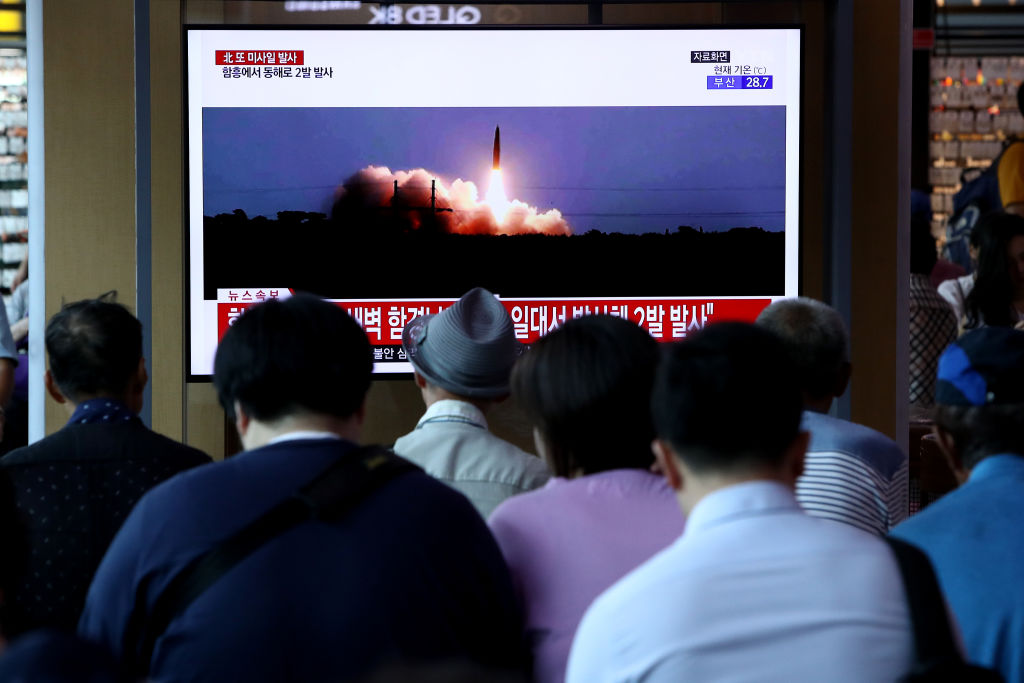The Corporate Media Never Talks About US Imperialism
The New York Times and other establishment outlets like to paint North Korea as an irrational actor hell-bent on destroying the United States. But you can’t understand North Korea’s nuclear program without talking about US militarism.

People watch a TV showing a file image of a North Korean missile launch at the Seoul Railway Station on August 10, 2019 in Seoul, South Korea. Chung Sung-Jun / Getty
On Tuesday, the New York Times issued a front-page warning: North Korea has been conducting missile tests that show technological advances aimed at subverting US missile defense systems.
Like so much reporting on US-DPRK matters, the article — coauthored by David Sanger and William Broad — manages to report something legitimately concerning (inflamed tensions between nuclear-armed countries is never a good thing) while conveniently ignoring the role that US militarism (excuse me, defense strategy) played in creating the problem in the first place.
Sanger and Broad report that the recent North Korean tests reveal “greater range and maneuverability that could overwhelm American defenses in the region.” Some of the missiles, they note, are designed to defeat missile defense systems like Aegis and Patriot, which the United States supplies to Japan and South Korea. The DPRK’s new missiles — which could carry either conventional or nuclear warheads — therefore threaten US allies and “at least eight American bases in those countries housing more than 30,000 troops.”
Pentagon stenographers like Sanger and Broad are unlikely to inquire why the United States has tens of thousands of troops and eight bases in Northeast Asia — one of which, Camp Humphreys, is the largest and most expensive US military base in the world. But defense journalists should at least acknowledge the risks of deploying missile defense technology in a region that is still technically at war — and where one of the belligerents has since developed a nuclear weapons program. Sanger and Broad remain mute on this point. Instead, they suggest — strangely — that North Korea’s missile tests are part of a “maximum pressure” campaign against the United States.
Needless to say, the idea that a besieged international pariah is capable of pressuring the United States into anything is silly. But this is the foreign policy establishment we’re talking about, where diplomacy itself is viewed as a concession to Kim Jong-un.
A more accurate, non-ridiculous explanation for the current tests is that they are part of an antagonistic spiral of weapons development and counter-development. The United States, having invested heavily in missile defense technologies, has gleefully encouraged Japan and South Korea to deploy them in recent years. (Remember THAAD?) The North Koreans, correctly viewing these moves as a threat to their own capabilities, have responded in a fairly logical way: by developing new technologies to thwart them. This isn’t shocking or surprising — it’s basically international relations 101.
While entirely predictable, it’s unfortunate that Sanger and Broad ignore this dynamic — because the United States’ obsession with missile defense is inflaming things not only on the Korean peninsula, but around the globe. The United States’ withdrawal from the Anti-Ballistic Missile Treaty in 2002 marked the quiet beginning of the collapse of nuclear arms control. The INF treaty, hatched between the Soviet Union and the United States in 1987, is now dead, in part because of a dispute related to US missile defense deployments in Europe. Russia’s scary new nuclear weapons that you’ve heard so much about? They’re designed to thwart US missile defenses. You can bet China is keeping a close eye on developments too.
It’s not hard to understand why. Strategic missile defense has a laughable track record, but nuclear-armed powers like China and Russia have to assume these systems might some day work. They face a choice: either invest in new technologies today or gamble with their own existence tomorrow. As James J. Cameron put it after the release of the 2019 Missile Defense Review, “The risk today is that both Moscow and Beijing may see any expanded missile defense as stepping up a suspected U.S. first strike option — in a crisis, destroying their offensive nuclear forces by attacking them preemptively.” He continues: “This could prompt a new arms race, with U.S. adversaries building larger numbers of more capable missiles [my emphasis].” That’s pretty much exactly what we’re seeing now — both in the regional (North Korea) and global (China and Russia) arenas.
Conveniently, the New York Times leaves out all of this background information — while also omitting the central role South Korean president Moon Jae-in has played in reducing tensions on the peninsula. The average reader could come away thinking North Korea is hell-bent on obliterating the United States and its allies, an irrational “hermit kingdom” barreling ahead with its nuclear program in an absolutely exceptional case of international recklessness.
A more useful starting point would be to examine the DPRK’s new missiles in relation to the American fetish for missile defense. But that would require casting a critical eye on US empire — and for that perspective, readers will have to look elsewhere.